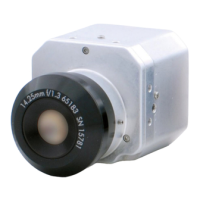1
Typical Monitoring and
Control Applications
Typical Monitoring and
Control Applications
Temperature Measurements
with IR Cameras
Infrared (IR) radiation is not detectable
by the human eye, but an IR camera
can convert it into a visual image that
depicts thermal variations across an
object or scene. IR covers a portion of
the electromagnetic spectrum from
approximately 900 to 14,000 nanometers
(0.9–14 µm). IR is emitted by all objects at
temperatures above absolute zero, and
the amount of radiation increases with
temperature. A properly calibrated IR
camera can capture thermographic images
of target objects and can provide accurate
non-contact temperature measurements
of those objects. These quantitative
measurements can be used in a variety of
monitoring and control applications.
In contrast, other types of IR imagers
provide only relative temperature
dierences across an object or scene.
Hence, they are used to make qualitative
assessments of the target objects,
primarily in monitoring applications
where thermal images are interpreted
based on temperature contrast. One
example is to identify image areas that
correlate to physical anomalies, such as
construction or sub-surface details, liquid
levels, etc.
In some cases, an IR camera is justiably
referred to as a smart sensor. In these
cases the IR camera has built-in logic
and analytics that allows the comparison
of measured temperatures with user-
supplied temperature data. It also has a
digital I/O interface so that a dierential
temperature can be used for alarm and
control functions. In addition, a smart
IR camera is a calibrated thermographic
instrument capable of accurate non-
contact temperature measurements.
IR cameras with these capabilities
operate much like other types of smart
temperature sensors. They have fast,
high-resolution A/D (Analog to Digital)
converters that sample incoming data,
pass it through a calibration function, and
provide temperature readouts. They may
also have other communication interfaces
that provide an output stream of analog
or digital data. This allows thermographic
images and temperature data to be
transmitted to remote locations for
process monitoring and control.
Generally, smart IR cameras are used
in quantitative applications that
require accurate measurements of the
temperature dierence between a
target object and its surroundings. Since
temperature changes in most processes
are relatively slow, the near-real-time data
communications of smart IR cameras are
adequate for many process control loops
and machine vision systems.
Automation Applications
Typical automated applications using
IR cameras for process temperature
monitoring and control include:
Continuous casting, extrusion, and roll •
forming
Discrete parts manufacturing•
Production where contact temperature •
measurements pose problems
Inspection and quality control•
Packaging production and operations•
Chapter 1

